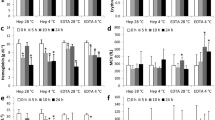Abstract
Glucose is utilized by fish as one of the sources of energy. It is a physiological parameter useful in the determination of the general health condition of cultured fish. The aim of this study was to determine the stability of plasma and blood glucose concentration, stored at different temperatures (4 °C and 30 °C) for 72 h. Two (2) milliliters of blood was collected via the caudal abdominal venipuncture of 10 female catfishes purchased. The fish were 8 months of age and were kept in plastic ponds at the Faculty of Veterinary Medicine, University of Nigeria. Blood was collected in blood tubes containing K2EDTA. Plasma was harvested from 1 mL of K2EDTA blood sample following centrifugation. Glucose concentration was determined using the Accu-Chek glucometer. Whole blood and plasma were analyzed immediately (0 h), and then after storage at 4 °C and 30 °C at 24 h, 48 h, and 72 h. Comparisons to the whole blood samples (0 h) stored at 30 °C revealed a significant (p < 0.05) decrease in blood glucose concentration from the 24th hour to the 72nd hour. At 4 °C, blood glucose concentration was stable for up to 72 h. Plasma glucose level was stable for 24 h, and significantly (p < 0.05) decreased from the 48th hour. When compared with the 0 h plasma glucose concentration at 4 °C, no significant (p > 0.05) differences in the 24-h, 48-h, and 72-h plasma glucose concentration were observed. Therefore, whole blood and plasma stored at 4 °C for 72 h and plasma stored at 30 °C for 24 h can be used for glucose determinations in the female African catfish.




Similar content being viewed by others
References
Agina OA, Ikechukwu PJ, Agina BC (2017) Stability of some clinical biochemistry parameters in equine serum/plasma stored at refrigerator and room temperatures: a preliminary study. Comp Clin Pathol 26:465–469. https://doi.org/10.1007/s00580-017-2399-1
Antwi-Baffour S, Quao E, Kyeremeh R, Mahmood SA (2013) Prolong storage of blood in EDTA has an effect on the morphology and osmotic fragility of erythrocytes. Int J Biomed Sci Eng 1(2):20–23
Astles JR, Petros WP, Peters WP, Sedor FA (1995) Artifactual hypoglycemia associated with hematopoietic cytokines. Arch Pathol Lab Med 119(8):713–716
Bartonkova J, Hyrsl P (2016) Vojtek L (2016) Glucose determination in fish plasma by two different moderate methods. Acta Vet Brno 85:349–353
Buttarello M (2004) Quality specification in haematology: the automated blood cell count. Clin Chem Acta 346:45–54
Christopher M, O’Neill S (2000) Effect of specimen collection and storage on blood glucose and lactate concentrations in healthy, hyperthyroid and diabetic cats. Vet Clin Pathol 29(1):22–28
Collicutt NB (2014) The effect of delayed serum separation and storage temperature on the rate of serum glucose concentration decline in alpacas, horses, dogs and sturgeon. MSc Thesis. The University of Georgia. Athens, Georgia
Garrett RH, Grisham CM (2013) Biochemistry, 5th edn. Brooks/Cole, Cengage Learning
Ihedioha JI, Onwubuche RC (2007) Artifactual changes in PCV, haemoglobin, and cell counts in bovine, caprine, and porcine blood stored at room and refrigerator temperatures. Vet Clin Pathol 36(1):60–63
Ihedioha JI, Idika KI, Ogamba GN, Akam CJN (2008) Changes in the haematological values of avian blood samples stored at varying temperatures for a period of up to 72 hours. Comp Clin Pathol 17(2):73–79
Kamalam BS, Medale F, Panserat S (2016) Utilisation of dietary carbohydrates in farmed fishes: new insights on influencing factors, biological limitations and future strategies. Aquaculture. https://doi.org/10.1010/j.aquaculture.2016.02.007
Melandez HE, Waddell TG, Cascante M (1996) The puzzle of the Krebs citric acid cycle: assembling the pieces of chemically feasible reactions, and opportunism in the design of metabolic pathways during evolution. J Mol Evol 43(3):293–303
Montel-Hagen A, Blanc L, Boyer Clavel M, Jacquet C, Vidal M, Sitbon M, Taylor N (2008) The Glut1 and Glut4 glucose transporters are differentially expressed during perinatal and postnatal erythropoiesis. Blood 112(12):4729–4738
Nikinmaa M, Tiihonen K (1994) Substrate transport and utilization in fish erythrocytes. Acta Physiol Scand 152(2):183–189
Nourrisson CL, Batisse M, Sapin V, Bouvier D (2010) Pseudo-hypoglycemia and hyperleukocytosis: a case report. Ann Biol Clin (Paris) 68(4):490–494
Sacks DB (2008) Carbohydrates. In: Burtis CA, Ashwood ER, Bruns DE (eds) Tietz fundamentals of clinical chemistry, 6th edn. St. Louis, Saunders Elsevier, p 373
Singh M, Pandya R, Chandra S, Sharma SK (2015) Stability of clinical chemistry and haematological analytes in preserved plasma and blood obtained from Wistar rats. Scand J Lab Anim Sci 41(6):1–6
Stockham SL, Scott MA (2008) Fundamentals of veterinary clinical pathology, 2nd edn. Blackwell Publishing, Iowa
Ybarra J, Isern J (2003) Leukocytosis-induced artifactual hypoglycemia. Endocr J 50(4):481–482
Young D, Bermes E, Haverstick D (2008) Separation and storage of specimens. In: Burtis CA, Ashwood ER, Bruns DE (eds) Tietz fundamentals of clinical chemistry. Saunders Elsevier, St. Louis, p 51
Acknowledgments
This study was supported by the personal contributions of all authors. No grant was made available for this study. We would like to thank Rebec farms and the Veterinary Clinical students on rotation in the Department of Veterinary Theriogenology and Reproductive diseases laboratory for their assistance.
Author information
Authors and Affiliations
Corresponding author
Ethics declarations
Conflict of interest
The authors declare that they have no conflict of interest.
Ethical approval
The research was carried out in accordance with the Ethics and Regulations guiding the use of animals and animal products, as approved by the University of Nigeria Senate committee on Medical and Research ethics.
Additional information
Publisher’s note
Springer Nature remains neutral with regard to jurisdictional claims in published maps and institutional affiliations.
Rights and permissions
About this article
Cite this article
Agina, O.A., Okoye, C.N. & Dan-Jumbo, S.O. Glucose levels are stable in stored blood and plasma samples of cultured female African catfish (Clarias gariepinus). Comp Clin Pathol 29, 385–389 (2020). https://doi.org/10.1007/s00580-019-03070-2
Received:
Accepted:
Published:
Issue Date:
DOI: https://doi.org/10.1007/s00580-019-03070-2




